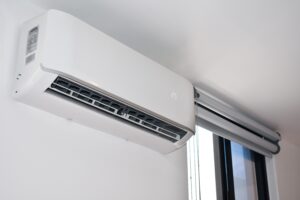Ductless Mini-Split Systems: The Perfect Solution for Additions & Sunrooms
The township of Abington, PA was founded in 1704 and is still a wonderful place for families to work and live today. If you live in Abington or the surrounding areas and plan to add to your home, it’s important to know which option for heating and cooling is best. The team at Chud Cooling and Heating explains why a ductless mini split for additions and sunrooms is a great choice.
Read on to learn more about how these systems work, the differences between them and a traditional HVAC system, and more on the advantages of ductless mini-split systems.

Why Ductless Mini-Splits Are the Best Option for Additions & Sunrooms
Just as the name implies, ductless mini-split systems don’t require the use of ductwork. This makes them much easier and more flexible to install, particularly for sunrooms and additions that may not have an overhead, wall, or sub-space space to hide bulky ductwork. These extremely energy-efficient systems also provide zoned temperature control, making them one of the best heating and cooling options for sunrooms.
How Do Ductless Mini-Splits Work?
A ductless mini-split system works by moving heat between the indoor and outdoor units using pressurized refrigerant. They’re similar to a heat pump but allow for independent installation in different rooms and don’t require ductwork to deliver treated air. Here’s more information about how these systems work:
- Mini split systems use an outdoor compressor/condenser unit and one additional indoor air-handling unit called an evaporator.
- The outdoor unit absorbs heat from the air regardless of the temperature, and the refrigerant takes the heat to the indoor units.
- The refrigerant releases the heat inside the indoor unit to warm the air for heating as it circulates through the room.
- For cooling, the indoor unit absorbs the heat from the air in the room, and the refrigerant transfers the heat to the outdoor unit and releases it outside.
Mini-Split vs. Traditional HVAC for Home Additions
Here’s what you need to know about mini split vs central air for home additions and sunrooms.
Ductwork vs No Ductwork
A traditional HVAC system requires ductwork to deliver the cooled or heated air to different rooms of your home. With a mini-split system, no ductwork is required, making it a good option for additions and smaller spaces. It’s a good choice in situations where adding ductwork isn’t feasible or when it’s too expensive to do so.
Zoned vs Not Zoned
When you turn on your HVAC, it automatically starts heating or cooling every room in your home. A mini-split system provides zoned heating and cooling, which means you’re only treating the air in the rooms you use or where and when you want to.
Installation Methods
A traditional HVAC system requires much more labor and more parts to install than a ductless mini-split system. If you install a mini split in an addition or sunroom, it may be as simple as cutting one hole in the wall for the system and connecting it there. A ductless mini split installation cost tends to be much lower at around $3,000 on average while also saving valuable space.
Key Benefits of Installing a Mini-Split in a Sunroom
So, are mini splits good for sunrooms? Here are some of the key benefits of installing a mini-split in a sunroom.
- Energy efficiency: Mini-split systems are very energy efficient and effectively heat or cool your sunroom without excess energy consumption or energy loss.
- Zoned control: You can independently control the temperature in your sunroom to keep it comfortable without affecting other areas of your home.
- Flexible to install: Ductless mini split systems are easy to install anywhere, making them a good option to suit the size and layout of your sunroom or home addition without ductwork.
- Quiet: Mini-split systems are praised for their quiet operation so you can sit back and relax in peace while spending time in your sunroom.
- Affordable: Installing a mini-split system is much less expensive than installing a new whole-home HVAC system and they also keep your energy costs lower thanks to their impressive energy efficiency.

What to Consider When Choosing a Mini-Split for Your Space
Consider these factors when you’re deciding on a ductless mini-split for your space.
Energy Efficiency
One of the biggest perks of a mini-split system is its energy efficiency. But how energy-efficient are ductless mini splits? An Energy Star-certified mini-split system uses approximately 60% less energy than a standard system, saving you money on monthly utility costs.
Size and Capacity
Do mini-splits work in extreme temperatures? Consider the size and capacity of your mini split, which is measured in BTUs. This should match the size of the space you need to heat and cool. If the unit is too small, it won’t be able to maintain comfortable temperatures. If it’s too large, it will cycle on and off, reducing its efficiency.
Installation
A skilled professional should install your new mini split system. Expert installation is the best way to make sure that your mini split is placed in the correct area, the refrigerant is properly charged, and that it’s safely connected to the electrical system.

Call Chud Cooling and Heating Today
With its compact size, no need for ductwork, and excellent energy efficiency, it’s easy to see why ductless mini-split systems are a good choice for home additions and sunrooms. The team at Chud Cooling and Heating is happy to help you choose the best system for your Abington, PA area home. If you’re ready for a consultation and installation of a mini-split system or want to learn more, contact us today!
